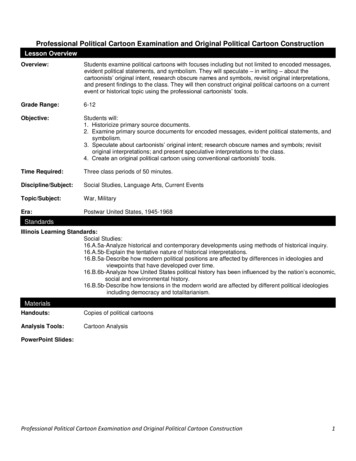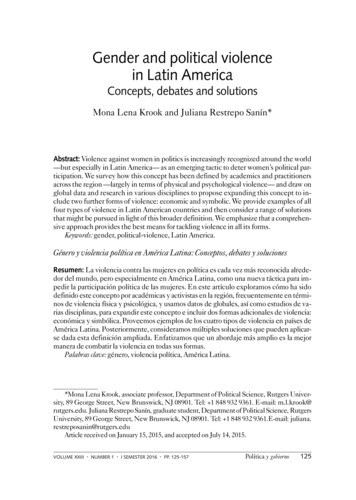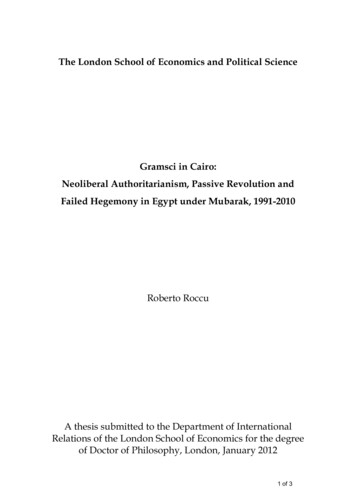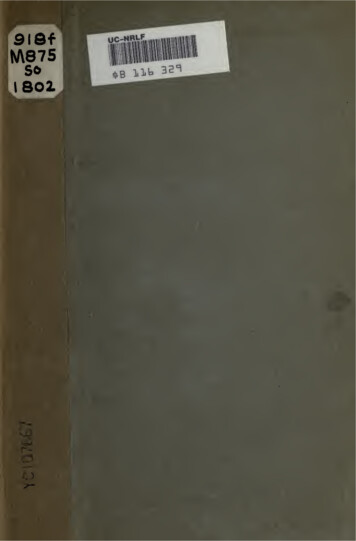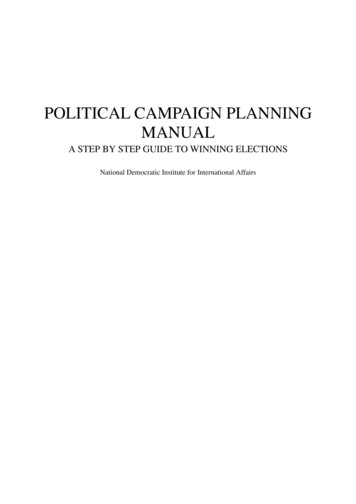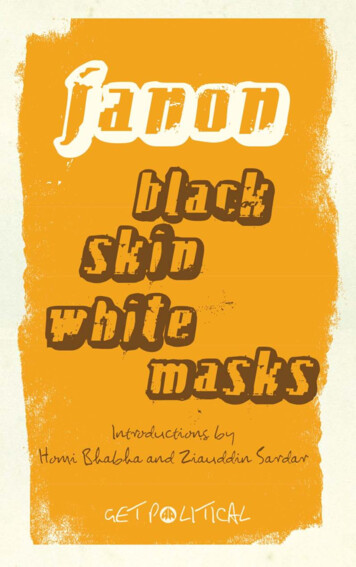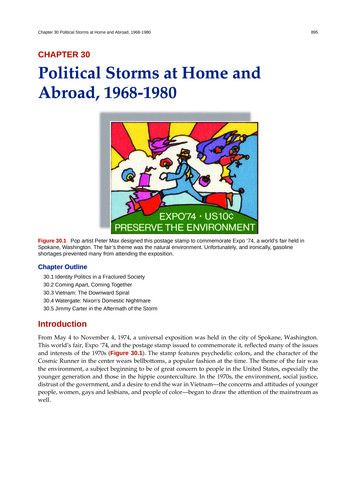
Transcription
Chapter 30 Political Storms at Home and Abroad, 1968-1980895CHAPTER 30Political Storms at Home andAbroad, 1968-1980Figure 30.1 Pop artist Peter Max designed this postage stamp to commemorate Expo Ô74, a worldÕs fair held inSpokane, Washington. The fairÕs theme was the natural environment. Unfortunately, and ironically, gasolineshortages prevented many from attending the exposition.Chapter Outline30.1 Identity Politics in a Fractured Society30.2 Coming Apart, Coming Together30.3 Vietnam: The Downward Spiral30.4 Watergate: NixonÕs Domestic Nightmare30.5 Jimmy Carter in the Aftermath of the StormIntroductionFrom May 4 to November 4, 1974, a universal exposition was held in the city of Spokane, Washington.This worldÕs fair, Expo Ô74, and the postage stamp issued to commemorate it, reflected many of the issuesand interests of the 1970s (Figure 30.1). The stamp features psychedelic colors, and the character of theCosmic Runner in the center wears bellbottoms, a popular fashion at the time. The theme of the fair wasthe environment, a subject beginning to be of great concern to people in the United States, especially theyounger generation and those in the hippie counterculture. In the 1970s, the environment, social justice,distrust of the government, and a desire to end the war in VietnamÑthe concerns and attitudes of youngerpeople, women, gays and lesbians, and people of colorÑbegan to draw the attention of the mainstream aswell.
896Chapter 30 Political Storms at Home and Abroad, 1968-198030.1 Identity Politics in a Fractured SocietyBy the end of this section, you will be able to: Describe the counterculture of the 1960s Explain the origins of the American Indian Movement and its major activities Assess the significance of the gay rights and womenÕs liberation movementsThe political divisions that plagued the United States in the 1960s were reflected in the rise of identitypolitics in the 1970s. As people lost hope of reuniting as a society with common interests and goals, manyfocused on issues of significance to the subgroups to which they belonged, based on culture, ethnicity,sexual orientation, gender, and religion.HIPPIES AND THE COUNTERCULTUREIn the late 1960s and early 1970s, many young people came to embrace a new wave of cultural dissent. Thecounterculture offered an alternative to the bland homogeneity of American middle-class life, patriarchalfamily structures, self-discipline, unquestioning patriotism, and the acquisition of property. In fact, therewere many alternative cultures.ÒHippiesÓ rejected the conventions of traditional society. Men sported beards and grew their hair long;both men and women wore clothing from non-Western cultures, defied their parents, rejected socialetiquettes and manners, and turned to music as an expression of their sense of self. Casual sex betweenunmarried men and women was acceptable. Drug use, especially of marijuana and psychedelic drugs likeLSD and peyote, was common. Most hippies were also deeply attracted to the ideas of peace and freedom.They protested the war in Vietnam and preached a doctrine of personal freedom to be and act as onewished.Figure 30.2This content is available for free at https://FQ[ RUJ/content/col11740/1.3
Chapter 30 Political Storms at Home and Abroad, 1968-1980897Some hippies dropped out of mainstream society altogether and expressed their disillusionment with thecultural and spiritual limitations of American freedom. They joined communes, usually in rural areas, toshare a desire to live closer to nature, respect for the earth, a dislike of modern life, and a disdain forwealth and material goods. Many communes grew their own organic food. Others abolished the conceptof private property, and all members shared willingly with one another. Some sought to abolish traditionalideas regarding love and marriage, and free love was practiced openly. One of the most famous communeswas The Farm, established in Tennessee in 1971. Residents adopted a blend of Christian and Asian beliefs.They shared housing, owned no private property except tools and clothing, advocated nonviolence, andtried to live as one with nature, becoming vegetarians and avoiding the use of animal products. Theysmoked marijuana in an effort to reach a higher state of consciousness and to achieve a feeling of onenessand harmony.Music, especially rock and folk music, occupied an important place in the counterculture. Concertsprovided the opportunity to form seemingly impromptu communities to celebrate youth, rebellion, andindividuality. In mid-August 1969, nearly 400,000 people attended a music festival in rural Bethel, NewYork, many for free (Figure 30.3). They jammed roads throughout the state, and thousands had to beturned around and sent home. Thirty-two acts performed for a crowd that partook freely of marijuana,LSD, and alcohol during the rainy three-day event that became known as Woodstock (after the nearbytown) and became the cultural touchstone of a generation. No other event better symbolized the culturalindependence and freedom of Americans coming of age in the 1960s.Figure 30.3 The crowd at Woodstock greatly exceeded the fifty thousand expected. Mark Goff covered Woodstockas a young freelance reporter for Kaleidoscope, a Milwaukee-based alternative newspaper, and captured this imageof Swami Satchidananda, who declared music Ò'the celestial sound that controls the whole universeÓ at the openingceremony.
898Chapter 30 Political Storms at Home and Abroad, 1968-1980MY STORYGlenn Weiser on Attending WoodstockOn the way to Woodstock, Glenn Weiser remembers that the crowds were so large they essentiallyturned it into a free concert:As we got closer to the site [on Thursday, August 14, 1969] we heard that so many peoplehad already arrived that the crowd had torn down the fences enclosing the festival grounds(in fact they were never put up to begin with). Everyone was being allowed in for free. . . .Early on Friday afternoon about a dozen of us got together and spread out some blankets onthe grass at a spot about a third of the way up the hill on stage right and then dropped LSD.I took Orange Sunshine, a strong, clean dose in an orange tab that was perhaps the beststreet acid ever. Underground chemists in southern California had made millions of doses,and the nation was flooded with it that summer. We smoked some tasty black hashish toamuse ourselves while waiting for the acid to hit, and sat back to groove along with RichieHavens.In two hours we were all soaring, and everything was just fine. In fact, it couldnÕt have beenbetterÑthere I was with my beautiful hometown friends, higher than a church steeple andlistening to wonderful music in the cool summer weather of the Catskills. After all, the dirtylittle secret of the late Ô60s was that psychedelic drugs taken in a pleasant setting could becompletely exhilarating.ÑGlenn Weiser, ÒWoodstock 1969 RememberedÓIn this account, Glenn Weiser describes both the music and his drug use. What social trends didWoodstock reflect? How might the festival have influenced American culture and society, bothaesthetically and behaviorally?AMERICAN INDIAN PROTESTAs the young, primarily white men and women who became hippies strove to create new identities forthemselves, they borrowed liberally from other cultures, including that of Native Americans. At the sametime, many Indians were themselves seeking to maintain their culture or retrieve elements that had beenlost. In 1968, a group of Indian activists, including Dennis Banks, George Mitchell, and Clyde Bellecourt,convened a gathering of two hundred people in Minneapolis, Minnesota, and formed the American IndianMovement (AIM) (Figure 30.4). The organizers were urban dwellers frustrated by decades of poverty anddiscrimination. In 1970, the average life expectancy of Indians was forty-six years compared to the nationalaverage of sixty-nine. The suicide rate was twice that of the general population, and the infant mortalityrate was the highest in the country. Half of all Indians lived on reservations, where unemployment reached50 percent. Among those in cities, 20 percent lived below the poverty line.This content is available for free at https://FQ[ RUJ/content/col11740/1.3
Chapter 30 Political Storms at Home and Abroad, 1968-1980899Figure 30.4 This teepee was erected on the National Mall near the Washington Monument as part of an AIMdemonstration (a). Note that the AIM flag (b) combines an Indian silhouette with the peace sign, the ubiquitoussymbol of the 1960s and Ô70s.On November 20, 1969, a small group of Indian activists landed on Alcatraz Island (the former site of anotorious federal prison) in San Francisco Bay. They announced plans to build an American Indian culturalcenter, including a history museum, an ecology center, and a spiritual sanctuary. People on the mainlandprovided supplies by boat, and celebrities visited Alcatraz to publicize the cause. More people joinedthe occupiers until, at one point, they numbered about four hundred. From the beginning, the federalgovernment negotiated with them to persuade them to leave. They were reluctant to accede, but over time,the occupiers began to drift away of their own accord. Government forces removed the final holdouts onJune 11, 1971, nineteen months after the occupation began.
900Chapter 30 Political Storms at Home and Abroad, 1968-1980DEFINING "AMERICAN"Proclamation to the Great White Father and All His PeopleIn occupying Alcatraz Island, Indian activists sought to call attention to their grievances and expectationsabout what America should mean. At the beginning of the nineteen-month occupation, Mohawk RichardOakes delivered the following proclamation:We, the native Americans, re-claim the land known as Alcatraz Island in the name of allAmerican Indians by right of discovery.We wish to be fair and honorable in our dealings with the Caucasian inhabitants of this land,and hereby offer the following treaty:We will purchase said Alcatraz Island for twenty-four dollars ( 24) in glass beads and redcloth, a precedent set by the white manÕs purchase of a similar island about 300 years ago. .We feel that this so-called Alcatraz Island is more than suitable for an Indian Reservation, asdetermined by the white manÕs own standards. By this we mean that this place resemblesmost Indian reservations in that:1. It is isolated from modern facilities, and without adequate means of transportation.2. It has no fresh running water.3. It has inadequate sanitation facilities.4. There are no oil or mineral rights.5. There is no industry and so unemployment is very great.6. There are no health care facilities.7. The soil is rocky and non-productive; and the land does not support game.8. There are no educational facilities.9. The population has always exceeded the land base.10. The population has always been held as prisoners and kept dependent upon others.Further, it would be fitting and symbolic that ships from all over the world, entering the GoldenGate, would first see Indian land, and thus be reminded of the true history of this nation. Thistiny island would be a symbol of the great lands once ruled by free and noble Indians.What does the Alcatraz Proclamation reveal about the Indian view of U.S. history?Click and ExploreListen to Richard Oakes, one of the leaders of the Alcatraz Island occupation, as hereads the Alcatraz Proclamation .The next major demonstration came in 1972 when AIM members and others marched on Washington,DCÑa journey they called the ÒTrail of Broken TreatiesÓÑand occupied the offices of the Bureau of IndianAffairs (BIA). The group presented a list of demands, which included improved housing, education, andThis content is available for free at https://FQ[ RUJ/content/col11740/1.3
Chapter 30 Political Storms at Home and Abroad, 1968-1980901economic opportunities in Indian communities; the drafting of new treaties; the return of Indian lands; andprotections for native religions and culture.The most dramatic event staged by AIM was the occupation of the Indian community of Wounded Knee,South Dakota, in February 1973. Wounded Knee, on the Pine Ridge Indian Reservation, had historicalsignificance: It was the site of an 1890 massacre of members of the Lakota tribe by the U.S. Army. AIMwent to the reservation following the failure of a group of Oglala to impeach the tribal president DickWilson, whom they accused of corruption and the use of strong-arm tactics to silence critics. AIM used theoccasion to criticize the U.S. government for failing to live up to its treaties with native peoples.The federal government surrounded the area with U.S. marshals, FBI agents, and other law enforcementforces. A siege ensued that lasted seventy-one days, with frequent gunfire from both sides, wounding aU.S. marshal as well as an FBI agent, and killing two Indians. The government did very little to meetthe protestersÕ demands. Two AIM leaders, Dennis Banks and Russell Means, were arrested, but chargeswere later dismissed. The Nixon administration had already halted the federal policy of termination andrestored millions of acres to tribes. Increased funding for Indian education, healthcare, legal services,housing, and economic development followed, along with the hiring of more Indian employees in the BIA.GAY RIGHTSCombined with the sexual revolution and the feminist movement of the 1960s, the counterculture helpedestablish a climate that fostered the struggle for gay and lesbian rights. Many gay rights groups werefounded in Los Angeles and San Francisco, cities that were administrative centers in the network of U.S.military installations and the places where many gay men suffered dishonorable discharges. The firstpostwar organization for homosexual civil rights, the Mattachine Society, was launched in Los Angeles in1950. The first national organization for lesbians, the Daughters of Bilitis, was founded in San
Chapter 30 Political Storms at Home and Abroad, 1968-1980 897. MY STORY Glenn Weiser on Attending Woodstock On the way to Woodstock, Glenn Weiser remembers that the crowds were so large they essentially turned it into a free concert: As we got closer to the site [on Thursday, August 14, 1969] we heard that so many people had already arrived that the crowd had torn down the fences enclosing

